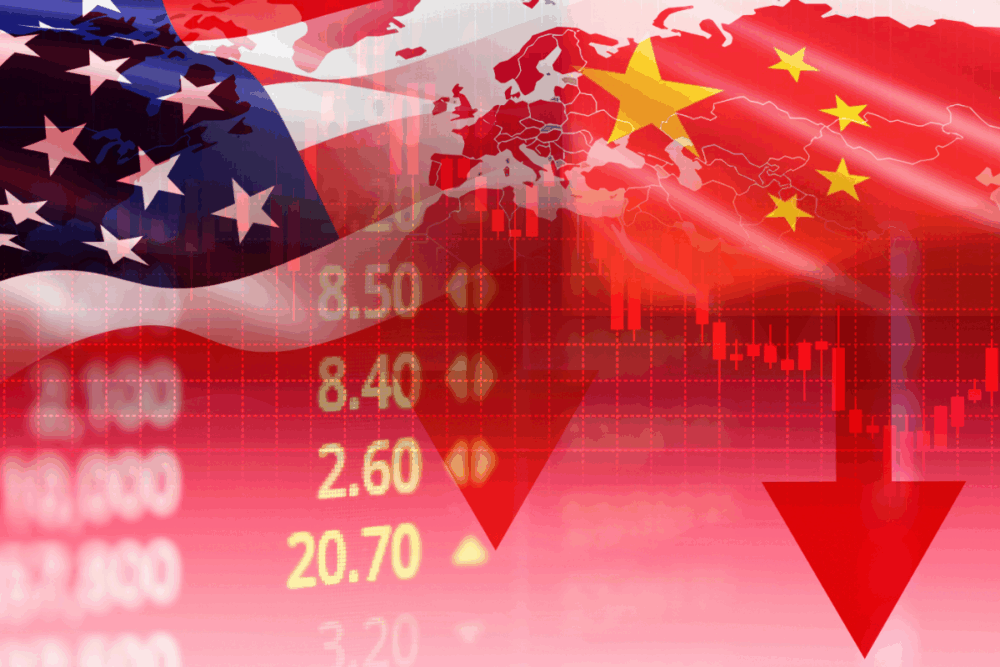Tariffs are back in the headlines with the second Trump administration. But what do they really achieve? Who benefits from them (if anyone)? And could they end up backfiring? Stéphane Auray, Economics Professor at the French National School for Statistics and Information Analysis (ENSAI) and at Rennes School of Business, has helped us clarify the situation by breaking down the key questions and answers — drawing lessons from the tariffs imposed during Trump’s first term and offering a critical look at the facts behind the political rhetoric.
The White House triggered a trade war that resulted in an additional 145% in tariffs on Chinese goods entering the United States, and 125% in retaliatory tariffs imposed by Beijing on goods coming from the US.
Regarding Europe, on April 9, President Trump announced a 90-day suspension on most of the reciprocal tariffs on imports he had announced the previous week (20% on imports from the EU, and 10% on imports from the UK). But as of today, the majority of EU goods sold into the US are still subject to a baseline 10% tariff.
1. What exactly are tariffs, and what are they supposed to achieve?
Tariffs are a tool of trade policy used by nearly all countries. They are taxes applied to imported goods. The idea is to make foreign products more expensive to encourage consumers and businesses to buy domestic alternatives instead. They are meant to help local businesses rebuild their profit margins.
However, tariffs don’t always boost public revenue. If the taxed imports become too expensive, demand may fall — sometimes even to zero — meaning no tariffs are collected at all.
2. What’s the goal behind Trump’s tariffs?
Trump’s tariff strategy is built on several bold goals: reducing the U.S. trade deficit, bringing manufacturing jobs back home, and reindustrializing the country. He argues that tariffs can encourage companies to relocate production to the U.S., especially when paired with tax breaks — a strategy tried during his first term, though it had limited success.
He also frames tariffs as a way to penalize China for what he calls unfair trade practices, such as currency devaluation and market manipulation.
Finally, there’s the promise of increasing public revenue through higher tariff income and attracting more foreign direct investment.
For Stéphane Auray, Economics Professor at the French National School for Statistics and Information Analysis (ENSAI) and at Rennes School of Business,
“Basically, the way the Trump administration frames tariffs is as a tax on foreign exports — not on Americans. From their perspective, it shouldn’t weigh on American households or businesses, since they’re not supposed to see price increases on the goods they buy. But what the Trump administration is really doing is retaliating. And Trump is convinced that by doing so, he’ll gain more leverage in trade negotiations.”
3. Didn’t Trump already try tariffs in his first term? How did that go?
Yes — Trump 1 launched tariffs with similar goals: reduce the trade deficit, boost local jobs, and punish China. But the results were mixed, at best, says Stéphane:
“Back then, tariffs were introduced alongside other major global disruptions: the COVID-19 pandemic and the war in Ukraine. While inflation did rise during that time, most Americans didn’t see tariffs as the sole cause — it was part of a much larger economic storm.
To counter inflation, the Federal Reserve raised interest rates — a classic contracyclical monetary policy move. That helped stabilize inflation somewhat, but it wasn’t because the tariffs worked; it was because monetary policy picked up the slack.
4. Did tariffs actually reduce the U.S. trade deficit?
Not really. According to the US Bureau of Economic Analysis, during Trump’s first term, the U.S. trade deficit actually grew — from around $620 billion in 2018 to nearly $1 trillion by 2022 (with a brief dip during COVID). Tariffs alone didn’t solve the imbalance.
For Stéphane,
“One of the key factors at play was the movement of the U.S. dollar. When imports decrease, the demand for foreign currencies — like the Chinese yuan, Indian rupee, or the euro — also drops. That, in turn, leads to an appreciation of the dollar. But a stronger dollar makes American goods more expensive for foreign buyers, which typically results in a decline in U.S. exports. That’s exactly what we observed during Trump’s first term when tariffs were ramped up.”
5. Can tariffs actually bring jobs back and boost U.S. industry?
That’s a central promise of Trump’s economic agenda — that tariffs will protect American workers, boost manufacturing, and drive reindustrialization. But in practice, there’s little evidence that they do.
Most studies show no meaningful increase in local employment during Trump’s first term. Gains in a few protected industries were often offset by losses elsewhere, especially in sectors dependent on imported inputs. In short, the expected job boom never came.
Trump linked tariffs to reshoring production, but his broader agenda also includes a restrictive migration policy, which adds another layer to the problem.
“The idea that American workers can simply replace cheap foreign labor — particularly from countries like China — ignores a key reality: U.S. wages are much higher. Replacing overseas factories with domestic ones means higher production costs and, ultimately, more expensive goods for consumers.”
7. So, tariffs mean inflation?
In fact, the biggest measurable effect of the tariffs was inflation. “The Impact of the 2018 Trade War on U.S. Prices and Welfare” study by economists Mary Amiti, Stephen J. Redding, and David E. Weinstein found that Trump’s trade measures led to substantial increases in the prices of U.S. manufactured goods. They concluded that the full incidence of the tariffs fell on domestic consumers, resulting in a reduction in U.S. real income of $1.4 billion per month by the end of 2018.
“And while Trump promised higher public revenues, the actual increase in tariff income was minimal in 2018–2019 — not nearly enough to justify the broader economic damage. So, while Trump claims he’ll lower prices, his first term actually delivered the opposite: higher tariffs and higher inflation.”
So in the current tariff situation, despite Trump’s claim that foreign exporters will ‘pay’ the tariff, the cost will almost certainly be passed down the supply chain — ultimately leading to higher prices at home.
8. And what about China — did tariffs actually hurt them?
Tariffs were aimed squarely at China, but the real impact was more complex than expected. During Trump’s first term, Chinese imports to the U.S. dropped, but that void was quickly filled by other countries — notably India, Vietnam, and Mexico. So while China took a hit, it wasn’t isolated or long-lasting.
“Another side effect? Many Chinese companies simply adapted. Faced with higher tariffs, they shifted production to countries like Mexico — a tactic known as tariff jumping. That way, they could continue selling to the U.S. without being hit by the tariffs directly.”
So rather than reshaping global supply chains in the U.S.’s favor, the tariffs triggered a game of geopolitical musical chairs. The products still reached the U.S., just with a different label.
And the broader consequences? Not great for anyone. Tariffs led to higher inflation, a net loss in global GDP, and economic pain across the board — not just for China, but also for the U.S. and Europe.
“This wasn’t a “win-win” scenario. If the goal is to counterbalance China’s dominance, the better approach is through strategic trade partnerships, targeted investment, and diplomacy, not brute-force economic warfare.”
9. Are there any positive effects at all?
For Stéphane Auray, it’s hard to pinpoint clear benefits.
“One potential upside: some industries — like nuclear or defense tech in France— could see renewed focus domestically, but only if paired with smart investment and political cooperation. Otherwise, the positives are limited and sector-specific.”
10. Could Trump’s tariff strategy undermine America’s global economic leadership?
For Stéphane, what’s striking about the current approach isn’t just the return of tariffs — it’s the broader shift it signals. Historically, the U.S. has benefited from two key pillars: the dominance of the dollar, and its unique ability to attract global investment, especially into innovation hubs like Silicon Valley.
“But Trump’s second-term rhetoric and policies, including his stance on science, academia, and global cooperation, risk eroding that trust. If the U.S. becomes seen as unreliable or inward-looking, it might not just lose trade — it could lose its golden goose.”
Interested in knowing more about the current trade-war? Explore our other stories on their impact on European and U.S. industries.










![Image [Best of 2025] Power Moves in the Energy World](/wp-content/uploads/sites/3/energy-320x213.jpg)